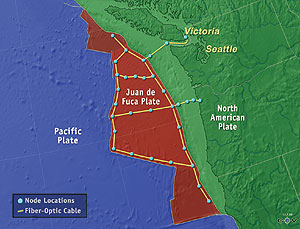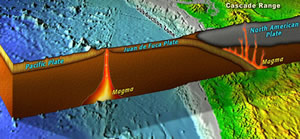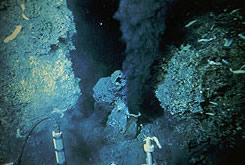
A Telescope Trained on 'Inner Space'
Neptune is currently in its development phase. Its feasibility study was completed in 2000 with a half-million dollars from the National Oceanographic Partnership. Since then the National Science Foundation has provided more than $3 million toward communications, sensor and network development and, just last summer, the project received a key $5 million award from the W.M. Keck Foundation of Los Angeles.

Project Neptune would link 30 experimental sites with 2,000 miles of fiber-optic and power cable—a mile or more beneath the ocean's surface. Project Neptune image.
The Keck Foundation focuses primarily on medical research, science and engineering. For example, it provided $110 million to the University of Southern California's School of Medicine for work focusing mainly on degenerative diseases of the brain, as well as backing the W.M. Keck Observatory in Hawaii.
Neptune can be likened to a telescope, Delaney says, one trained on "inner space." The support of a premier philanthropic foundation such as Keck is especially important now, he says, and allows the development of new kinds of instruments and experiments relating earthquakes and volcanic activity across a tectonic plate to the resulting flush of activity by micro-organisms.
The surface of the Earth is made up of a dozen or so major tectonic plates. All are floating on the planet's molten core that, slowly and constantly, moves the plates around. Among them are the Juan de Fuca Plate, west of us, and the North American Plate, on which the United States and Canada sit.
Where those two plates meet just miles off our coast, the Earth's forces are shoving the edge of the Juan de Fuca under the North American Plate. It's an area scientists call a subduction zone. A few hundred miles west, at the other side, the plate is pulling away from its seafloor neighbor at what's called a spreading center. As the crust pulls away, molten lava oozes up into the open spaces, creating new seafloor.

A computer rendering shows a subduction zone on the right, and a spreading center at left. Project Neptune image.
The pace of movement is usually only inches a year on both sides of the Juan de Fuca, but there can be more jolting movements. Hundreds of small earthquakes are detected around the plate each year, most of which go unfelt by those of us on land. When, instead of sliding smoothly under our continent, the Juan de Fuca and North American plates lock up, the resulting pressure can be released in large earthquakes. The February 2001 Nisqually Quake that struck Western Washington, although originating deep in the North American Plate, was not a subduction earthquake. An event in the 1700s was such a quake and reveals the potential power: It appears the Washington coastline dropped away as much as 6 feet in places and generated tsunamis that flooded coastal Japan.
"It's in the pattern of small earthquakes around the Juan de Fuca Plate where we may find the secrets of where and when the big earthquakes take place," Delaney says. While there are hundreds of seismometers on land across the region, there are few on the Juan de Fuca plate.
Last summer Neptune researchers from the United States and Canada sailed on the UW's 276-foot research vessel to map the seismically active Nootka Fault. The fault runs across the Juan de Fuca Plate and, where it meets the North American Plate, is a prime site to study the subduction zone. A better understanding of subduction quakes could save lives around the world, says John Madden of Canada's Institute for Pacific Ocean Science and Technology and vice chairman of the Neptune executive team. Madden is leading efforts to secure funding from his government for the portions of the network that will lie in Canadian waters.

Heated, mineral-rich fluid wells up from chimney-like structure on ocean floor in this image taken from the Alvin submersible vehicle. Project Neptune photo.
As one plate slides under the other, tons of sediments are scraped and squeezed, expelling methane, hydrogen and fluids laden with deep-dwelling micro-organisms. These micro-organisms help supply food to clams, worms and other members of what are called "cold-seep communities."
On the other side of the plate, the Endeavor Segment, a spreading center, is a showboat where volcanoes could erupt and hydrothermal vent structures form otherworldly landscapes.
The structures form after seawater circulates down into crevices and cracks in the seafloor, is heated by underlying magma chambers and becomes loaded with dissolved sulfur copper, iron, gold and silver. Eventually there is enough heat for the fluids to rise and vent back into the ocean, sometimes as forceful geysers hotter than 750 F. As the fluids mix with the much colder seawater, the minerals separate and solidify, piling up into impressive mounds, spires and chimney-like structures.
Brightly colored tubeworms, snails, scale worms, limpets and clams colonize these areas. Retrieved from the seafloor for study, such creatures can give off the stench of sulfur, like rotting eggs, because of the "diet" provided them by primitive bacteria.
- Return to December 2001 Table of Contents